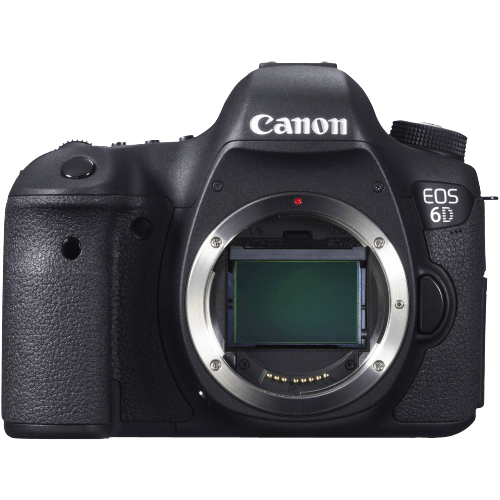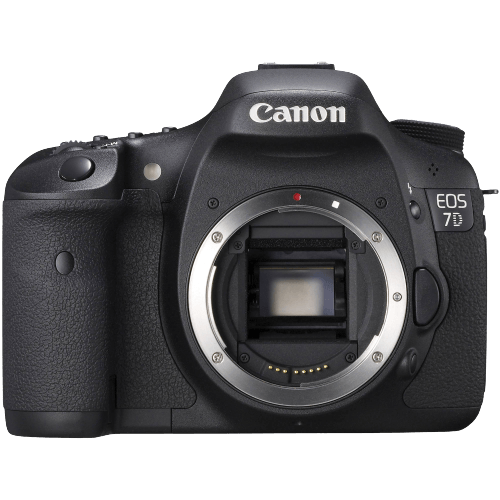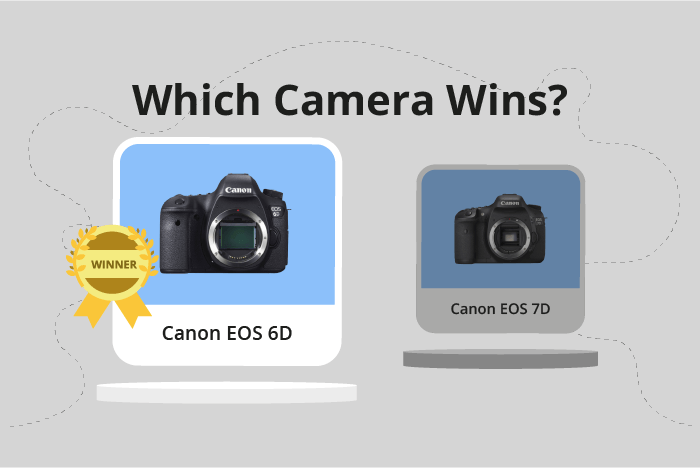Canon EOS 6D vs EOS 7D Comparison
Canon EOS 6D

Canon EOS 7D

The Canon EOS 6D outperforms the Canon EOS 7D with a score of 59/100 compared to 45/100. Both cameras are DSLRs, announced in 2012 and 2009, respectively. They share similar dimensions, with the 6D measuring 145 x 111 x 71mm and the 7D at 148 x 111 x 74mm. However, the 6D is lighter at 770g, while the 7D weighs 860g.
The EOS 6D’s higher score reflects its superior performance. Its lighter weight makes it more convenient for photographers to carry around. On the other hand, the EOS 7D has a slightly lower launch price of $1974 compared to the 6D’s $2099, making it more affordable.
Considering these factors, the Canon EOS 6D stands out as the better choice due to its higher score and lighter weight. However, the EOS 7D may appeal to budget-conscious photographers.
Canon EOS 6D vs EOS 7D Overview and Optics
The Canon EOS 6D outperforms the Canon EOS 7D in optics with a score of 61/100 compared to the 7D’s 43/100. Both cameras share certain specifications, such as a CMOS sensor type, no image stabilization, and a Canon lens mount. However, there are notable differences that make the 6D superior in terms of optics.
The 6D boasts a higher megapixel count at 20.2, compared to the 7D’s 18 megapixels. This results in sharper and more detailed images. Additionally, the 6D has a full-frame sensor size, while the 7D uses an APS-C sensor. The full-frame sensor provides better low-light performance and a shallower depth of field, contributing to the 6D’s higher DXOMARK sensor score of 82, as opposed to the 7D’s score of 66. The 6D also benefits from a more advanced processor, the Digic 5+, which enhances image quality and processing speed.
On the other hand, the 7D does have a faster shooting speed of 8 frames per second, compared to the 6D’s 4.5. This makes the 7D more suitable for capturing fast-moving subjects or action photography. However, this advantage does not outweigh the overall superior optics of the 6D.
Taking these factors into account, the Canon EOS 6D emerges as the clear winner in terms of optics, with a higher megapixel count, full-frame sensor, and more advanced processor. While the 7D offers a faster shooting speed, it falls short in other crucial areas, making the 6D the better choice for those prioritizing image quality and low-light performance.
Canon EOS 6D vs EOS 7D Video Performance
When comparing the video capabilities of the Canon EOS 6D and Canon EOS 7D, both cameras have a video score of 43 out of 100. This shows that their video performance is quite similar. In fact, they share several common specifications, such as Full HD maximum video resolution and maximum video dimensions of 1920 x 1080. Additionally, both cameras have a maximum video frame rate of 30fps and do not have built-in time-lapse functionality.
Despite the identical scores, there are areas where one camera may outperform the other. For the Canon EOS 6D, it provides better low-light performance and a larger sensor, which can contribute to improved video quality. This is especially beneficial for those who frequently shoot in low light conditions, as the larger sensor can capture more light for better image quality.
On the other hand, the Canon EOS 7D has a faster autofocus system, which is useful for tracking moving subjects while recording video. This may be more important for those who shoot sports or wildlife videos, as the faster autofocus system can keep up with the fast-paced action.
In comparing the video capabilities of these two cameras, it is clear that they have many similarities, but each has its own strengths. The Canon EOS 6D is better suited for low light conditions, while the Canon EOS 7D excels in fast-paced shooting situations. Ultimately, the choice between these two cameras depends on the specific needs and preferences of the user.
Canon EOS 6D vs EOS 7D Features and Benefits
The Canon EOS 6D wins the feature comparison with a score of 57/100, while the Canon EOS 7D trails slightly behind with a score of 54/100. Both cameras share some common specifications, such as a 3-inch screen size, no touchscreen, and no flip screen.
The Canon EOS 6D’s superiority is evident in its higher screen resolution (1,040,000 dots compared to the EOS 7D’s 920,000 dots), as well as the presence of GPS and WIFI capabilities. These features allow the EOS 6D to deliver clearer image previews on its LCD screen and provide convenient connectivity options for photographers.
In contrast, the Canon EOS 7D lacks GPS, WIFI, and Bluetooth capabilities. While this might seem like a disadvantage, some photographers may prefer the EOS 7D’s simpler and more focused design, without the need for additional connectivity options. This could result in a more streamlined shooting experience for those who prioritize simplicity over advanced features.
Considering these points, the Canon EOS 6D emerges as the better camera in terms of features, offering a higher screen resolution and additional connectivity options. The Canon EOS 7D, on the other hand, may appeal to those seeking a more straightforward shooting experience without the extra features. Ultimately, the choice between the two cameras will depend on the individual photographer’s preferences and needs.
Canon EOS 6D vs EOS 7D Storage and Battery
The Canon EOS 6D outperforms the Canon EOS 7D in storage and battery with a score of 45/100 compared to 35/100. Both cameras have one memory card slot, and neither offers USB charging. They also share the same battery type, the LP-E6.
The 6D has an advantage in battery life, offering 1090 shots compared to the 7D’s 800 shots. Additionally, the 6D accepts SD, SDHC, and SDXC memory cards, which are more widely used than the Compact Flash, UDMA, and Microdrive cards accepted by the 7D.
The 7D does not have any advantages in storage and battery over the 6D. The longer battery life and more common memory card compatibility make the Canon EOS 6D a better choice for photographers who prioritize storage and battery performance.
Alternatives to the Canon EOS 6D and EOS 7D
Are you still undecided about which camera is right for you? Have a look at these popular comparisons that feature the Canon EOS 6D or the Canon EOS 7D:

